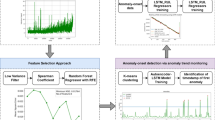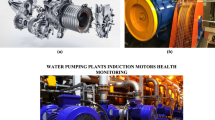Abstract
This paper reports on a new back propagation (BP) neural network based on an improved shuffled frog leaping algorithm (ISFLA) and its application in bearing fault diagnosis. The ISFLA is developed on the basis of a chaotic operator and the convergence factor of particle swarm optimization to overcome the shortcomings of conventional shuffled frog leaping algorithm (SFLA). Testing results show that the proposed algorithm can effectively improve the solution accuracy and convergence properties and exhibits an excellent ability of global optimization in high-dimensional space. The presented ISFLA is then employed to optimize the weights and threshold values of BP neural network. An ISFLA-BP network model is established for the early fault diagnosis of rolling bearings. The proposed ISFLA-BP scheme has been compared with BP and SFLA-BP networks through experimental studies. Results indicate that the developed new model demonstrates better generalization capability and stronger robustness. It is able to effectively improve the efficiency of network training and the accuracy of early fault pattern recognition in bearing fault diagnosis tasks.











Similar content being viewed by others
References
Stack J, Habetler T, Harley R (2004) Fault classification and fault signature production for rolling element bearings in electric machines. IEEE Trans Ind Appl 40(3):735–739
Bin G, Gao J, Li X (2012) Early fault diagnosis of rotating machinery based on wavelet packets-empirical mode decomposition feature extraction and neural network. Mech Syst Signal Process 27:696–711
Bellini A, Filippetti F, Tassoni C, Capolino GA (2008) Advances in diagnostic techniques for induction machines. IEEE Trans Ind Electron 55(12):4109–4126
Zhao Z, Zhang J, Sun Y, Tian H (2014) Fault detection and diagnosis method for batch process based on ELM-based fault feature phase identification. Neural Comput Appl. doi:10.1007/s00521-014-1655-4
Wang H, Chen P (2011) Fuzzy diagnosis method for rotating machinery in variable rotating speed. IEEE Sens J 11(1):23–34
Han X, Xiong J, Sun R, Wang L, Qin X (2013) Research on the roller bearing fault diagnosis based on Morphological wavelet and LSSVM algorithm. In: Proceedings of 2013 international conference on quality, reliability, risk, maintenance, and safety engineering (QR2MSE), p1888–1892
Bianchini C, Immovilli F, Cocconcelli M, Rubini R, Bellini A (2011) Fault detection of linear bearings in brushless ac linear motors by vibration analysis. IEEE Trans Ind Electron 58(5):1684–1694
Balanica V, Liao L, Claussen H, Rosca J (2013) A multi-model approach for anomaly detection and diagnosis using vibration signals. In: Proceedings of 2013 IEEE International Conference on Prognostics and Health Management, p 1–7
Liu H, Tian H, Chen C, Li Y (2013) An experimental investigation of two wavelet-MLP hybrid frameworks for wind speed prediction using GA and PSO optimization. Int J Electr Power Energy Syst 52(1):161–173
Bashir ZA, El-Hawary ME (2009) Applying wavelets to short-term load forecasting using PSO-based neural networks. IEEE Trans Power Syst 24(1):20–27
Deng A, Zhao L, Xin W (2011) Application of quantum neural networks in localization of acoustic emission. J Syst Eng Electron 22(3):507–512
Sivagaminathan RK, Ramakrishnan S (2007) A hybrid approach for feature subset selection using neural networks and ant colony optimization. Expert Syst Appl 33(1):49–60
Karaboga D, Basturk B (2007) A powerful and efficient algorithm for numerical function optimization: artificial bee colony (ABC) algorithm. J. Glob Optim 39(3):459–471
Eusuff MM, Lansey KE, Pasha F (2006) Shuffled frog-leaping algorithm: a memetic meta-heuristic for discrete optimization. Eng Optim 38(2):129–154
Eghbal M, Saha TK, Hasan KN (2011) Transmission expansion planning by meta-heuristic techniques: a comparison of shuffled frog leaping algorithm, PSO and GA. In: Proceedings of 2011 IEEE PES General Meeting, p 1–8
Gomez-Gonzalez M, Jurado F, Perez I (2012) Shuffled frog-leaping algorithm for parameter estimation of a double-cage asynchronous machine. IET Electr Power Appl 6(8):484–490
Ebrahimi J, Hosseinian SH, Gharehpetian GB (2011) Unit commitment problem solution using shuffled frog leaping algorithm. IEEE Trans Power Syst 26(2):573–581
Xu L, Fei M, Jia T, Yang TC (2012) Bandwidth scheduling and optimization using non-cooperative game model-based shuffled frog leaping algorithm in a networked learning control system. Neural Comput Appl 21(6):1117–1128
Ye H, Yang L, Liu X (2013) Optimizing weight and threshold of BP neural network using SFLA: applications to nonlinear function fitting. In: Proceedings of 4th International Conference on Emerging Intelligent Data and Web Technologies (EIDWT) 2013, p 211–214
Hu F, Liang RY, Li DX, Zhao L (2009) Application of shuffled frog leaping algorithm and wavelet neural network in sound source location. In: Proceedings of 1st International Conference on Information Science and Engineering (ICISE) 2009, p 3600–3604
Zhao Y, Dong ZC, Li QH (2011) ANN based on SFLA for surface water quality evaluation model and its application. In: Proceedings of International Conference on Transportation, Mechanical, and Electrical Engineering (TMEE) 2011, p 1615–1618
Chen Y, Wen J, Jiang L, Cheng S (2013) Hybrid algorithm for dynamic economic dispatch with valve-point effects. IET Gener Transm Distrib 7(10):1096–1104
Huynh TH (2008) A modified shuffled frog leaping algorithm for optimal tuning of multivariable PID controllers. In: Proceedings of IEEE International Conference on Industrial Technology, 1–6 2008
Roy P, Chakrabarti A (2011). Implementation of genetic algorithm and modified shuffled frog leaping algorithm for transmission loss minimum re-scheduling. In: Proceedings of 2011 Annual IEEE India Conference: Engineering Sustainable Solutions, p 1–4
He D, He C, Jiang LG, Zhu HW, Hu GR (2001) Chaotic characteristics of a one-dimensional iterative map with infinite collapses. IEEE Trans Circut Syst I Fundam Theor Appl 48(7):900–906
Clerc M, Kennedy J (2002) The particle swarm-explosion, stability, and convergence in a multidimentional complex space. IEEE Trans Evol Comput 6(1):58–73
Rumelhart DE, Hinton GE, Williams RJ (1986) Learning representations by back-propagating errors. Nature 323(9):533–536
The Case Western Reserve University. Bearing data center [EB/O- L] [2013-8.13]. http://www.eecs.cwru.edu/laboratory/bearing/
Espinosa AG, Rosero JA, Cusido J, Romeral L, Ortega JA (2010) Fault detection by means of Hilbert Huang transform of the stator current in a PMSM with demagnetization. IEEE Trans Energy Convers 25(2):312–318
Amarnath M, Praveen Krishna IR (2012) Empirical mode decomposition of acoustic signals for diagnosis of faults in gears and rolling element bearings. IET Sci Meas Technol 6(4):279–287
Richman JS, Moorman JR (2000) Physiological time-series analysis using approximate entropy and sample entropy. Am J Physiol Heart Circ Physiol 278(6):H2039–H2049
Luo J, Li X, Chen M (2012) The Markov model of shuffled frog leaping algorithm and its convergence analysis. Acta Electron Sin 8(12):2875–2880
Acknowledgments
This work was supported in part by the National Natural Science Foundation of China under Grant 51075070, in part by the Jiangsu Province Research Innovation Program for College Graduates, China, under Grant CXZZ_0139, in part by the Anhui Province Foundation for Youth Scholars of Educational Commission, China, under Grant 2012SQRL085, in part by Anhui Province Natural Science Foundation of China under Grant 1308085ME78, and in part by the Macao Science and Technology Development Fund under Grant 070/2012/A3.
Author information
Authors and Affiliations
Corresponding author
Rights and permissions
About this article
Cite this article
Zhao, Z., Xu, Q. & Jia, M. Improved shuffled frog leaping algorithm-based BP neural network and its application in bearing early fault diagnosis. Neural Comput & Applic 27, 375–385 (2016). https://doi.org/10.1007/s00521-015-1850-y
Received:
Accepted:
Published:
Issue Date:
DOI: https://doi.org/10.1007/s00521-015-1850-y




